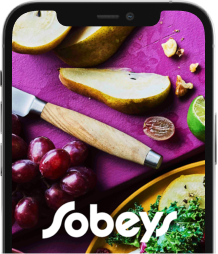We’re breaking down everything there is to know about this underrated fall fruit! Learn about selection, storage, best uses, and more!
The persimmon is an underrated fall and winter fruit with a cinnamony, honey-like flavour and a juicy, almost jellylike flesh.
Though deriving from Asia, persimmons are now grown around the world. There are dozens of different types and strains to choose from, making it a versatile fruit. Whether they’re enjoyed as a fresh snack, preserved as jam, or baked in desserts, you’ll fall in love with this unique and delicious fruit.
Astringent versus non-astringent
There are two major categories of persimmons: astringent and non-astringent.
Astringent persimmons are high in tannins. Think about how it feels to taste over-steeped black tea, where the astringency and high tannin content make your mouth dry and pucker up. When fully ripe, an astringent persimmon is mouth-watering, tender, and delightful.
A non-astringent persimmon is firm and hardy and can be eaten right away, even at its firmest.
Most popular types of persimmons
Hachiya Persimmon
The most common astringent persimmon hails from China and is pale in colour and heart- or acorn-shaped. When ripe, the fruit is soft and jellylike and melts in your mouth!
Fuyu Persimmon
The most common astringent persimmon hails from China and is pale in colour and heart- or acorn-shaped. When ripe, the fruit is soft and jelly-like and melts in your mouth!
In season: November to December
Best uses: The custard-like flesh makes the Hachiya persimmon ideal for use in baked goods such as muffins, breads, and puddings. You can also eat it fresh: just remove the stem, cut it open, and use a spoon to scoop out the fruit inside.
American Persimmon
The popular non-astringent persimmon hailing from Japan is short and wide like a tomato and can be eaten like an apple when firm, skin and all.
In season: October to December
Best uses: Fuyu persimmons are great in salads, added to cereal, or frozen to use in smoothies. You can bake with them, too, as you would apples.
Sharon Persimmon (or Sharon Fruit)
This American variety is astringent, so it’s best when eaten soft. It tends to be smaller and sweeter than its Asian counterparts. American persimmons are ideal for preserves and baked goods.
In season: September to December
Best uses: You can preserve American persimmons by creating a lovely jam. Plus, you can reduce food waste by infusing vinegar with its skins and seeds; an infused vinegar can then be used for a flavourful salad dressing.
Rojo Brillante Persimmon
In the 1970s, a method for removing tannins from astringent persimmons was developed so that they could be enjoyed while still firm, giving birth to the Sharon fruit! This variety can be eaten firm or ripe and is without a core or seeds.
In season: fall and winter months (as early as October, as late as March)
Best uses: Sharon fruit can be eaten similarly to a Fuyu persimmon. The fruit has a high sugar content, which means it lends itself to being frozen, making it a great option for smoothies or future baking projects.
What’s the Difference Between Kaki Fruit and a Persimmon?
This tomato-shaped astringent variety from Spain boasts a deep-orange skin and soft jellylike flesh. Since this is an astringent persimmon, feel free to take a bite when it’s fresh and firm!
In season: mid-October until January
Best uses: Eat this tasty fruit like an apple with the skin on or peel it and slice off the top. The seedless juicy flesh is ideal for children, and the fruit can be eaten whole or cut into wedges.
What’s the Difference Between Kaki Fruit and a Persimmon?
If you come across the term “kaki fruit” being used to describe what looks like a persimmon; both terms refer to the tropical fruit, but “Persimmon” is the more commonly used name. If you see “persiMon®”, that is a trademark registered by the PDO Kaki Ribera del Xúquer, the largest producing area of this fruit in Spain, north of Valencia. Both the Spanish kaki fruit and the persimmon are of the Rojo Brillante variety, only the former is less astringent. This holiday, be sure to try a Spanish kaki fruit, available in our Produce Dept.
If You’re Craving more, Try These Delicious Less Common Varieties:
- Tsurunoko (“chocolate” persimmon)
- Maru (“cinnamon” persimmon)
- Hyakume (“brown sugar” persimmon)
- Gosho (“giant Fuyu” persimmon)
- Tamopan (“mango” persimmon)
How to tell if persimmons are ripe
For an astringent persimmon, you’ll want to test the softness of the fruit to see how ripe it is. A ripe persimmon that’s ready to eat will give a little when gently pressed and the skin may be a little wrinkled. The colour may darken slightly, too, to a deeper orange-red. If the astringent persimmon needs a little extra time to hit its sweet spot, leave it to ripen at room temperature in a cool, dry area until soft.
A non-astringent persimmon is ready to eat when its colour is fully developed, but for best flavour, allow it to soften a little after you purchase them.
How to store persimmons
Generally, persimmons should be stored at room temperature until they’re ripe. Once ripe, persimmons can be placed in the fridge, where they can last for up to a few weeks.
If stored in a cool, dry, dark pantry, most persimmons should have a fairly long shelf life. Many persimmon varieties can also be frozen for future use; persimmons with a higher sugar content do better when frozen. Ripe persimmons can be preserved by turning them into jams or being canned.






